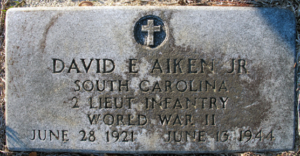Scroll of Honor – “D. E.” Aiken
Hedgerow Hero
Seventy-five years ago this week, Allied forces were struggling to  expand and reinforce the Normandy beachhead bought with such sacrifice on D-Day. During the first week on French shores, the Allies faced the daunting task not only of fighting the German defenders, but of supplying two armies with rations, ammunition, fuel, vehicles, weapons, clothing, equipment—and replacements for the dead and wounded—via a tenuous supply line stretching from British ports to the artificial harbors the Allies had anchored off of Omaha and Gold Beaches.
expand and reinforce the Normandy beachhead bought with such sacrifice on D-Day. During the first week on French shores, the Allies faced the daunting task not only of fighting the German defenders, but of supplying two armies with rations, ammunition, fuel, vehicles, weapons, clothing, equipment—and replacements for the dead and wounded—via a tenuous supply line stretching from British ports to the artificial harbors the Allies had anchored off of Omaha and Gold Beaches.
The 2nd Infantry Division had crossed the English Channel on D+1, landing over Omaha Beach near Saint-Laurent-Sur-Mer. With the division was twenty-two year-old Second Lieutenant David Edgar Aiken, Jr. from the Clarendon County community of New Zion.
“D. E.” Aiken had entered Clemson in 1938, before most Americans perceived the threat posed by happenings in Europe and the far Pacific. An agronomy major, D. E. was a member of the Sumter-Clarendon County Club and earned the Marksman badge at ROTC summer training held at Clemson in 1941. D. E. had served as a cadet second lieutenant during his senior year, suggesting that while he had continued to work toward a commission through the ROTC, his military record on campus had been undistinguished. When the Japanese bombed Pearl Harbor in December of that year, the future prospects for all the cadets took on a new, more ominous cast.
Following graduation in June, D. E., like most of the young men in the Class of 1942, reported for military service. He was sent first to Camp Wolters, Texas and was assigned to the 38th Infantry Regiment of the 2 Infantry Division. In October 1943, the Division shipped out to Northern Ireland where it continued to train and prepare for the anticipated invasion of France.
D-Day found the young platoon leader and his men anxiously awaiting their turn to cross the Channel and join the largest amphibious operation ever attempted. Landing on the day after the initial invasion, the 2nd Infantry Division was quickly committed to battle. On June 10, the division liberated the French town of Trévières, then attacked and secured key high ground on the road toward Saint-Lô.
Allied planners, despite the initial success of the invasion, had overlooked a key terrain feature of Normandy: its hedgerows. Hedgerows, known by the French as “bocage,” were small, man-made earthen walls that surrounded the Norman fields. Dating back to Roman times, they were topped by thick hedges, as much as six feet wide at the base, and were used to enclose pastures and mark property lines. They created nightmares for tactical movement, offering the defending Germans ample cover and concealment while making perilous the advance of American troops.
On June 13, a week after the initial landings, D. E.’s platoon was protecting the flank of the battalion as it advanced through the bocage. As D. E. led his platoon across a hedgerow, he encountered a sunken road over which the platoon had to advance. Following sound tactics, D. E. dispatched scouts to cross the road and reconnoiter the other side before sending the entire platoon across. As the scouts crossed the open road, they were cut down by a hidden enemy machine gun. According to the posthumous Silver Star citation, “Lieutenant Aiken personally directed the neutralizing of the position and then ordered his platoon to cover his advance as he went forward to draw fire from other enemy emplacements.” D. E. was killed by another enemy machine gun, “but his actions enabled the platoon to knock out the position and continue its advance.”
Hundreds of acts of valor like D. E.’s would eventually allow the Allies to  break out of the beachhead and push the Germans back across the Rhine River and into Germany.
break out of the beachhead and push the Germans back across the Rhine River and into Germany.
David Edgar Aiken, Jr., was survived by his father, a World War I veteran of the famous Rainbow Division, who had served in France twenty-six years earlier.
For more information about Lieutenant David Edgar Aiken, Jr. see:
https://soh.alumni.clemson.edu/scroll/david-edgar-aiken-jr/
For information about Clemson University’s Scroll of Honor visit:
https://soh.alumni.clemson.edu/
